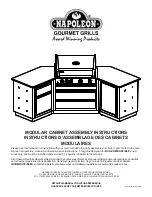
5
ENGLISH
(Original instructions)
c.
Disconnect the plug from the power source and/or
remove the battery pack, if detachable, from the power
tool before making any adjustments, changing
accessories,
or storing power tools. Such preventive
safety measures reduce the risk of starting the power
tool accidentally.
d.
Store idle power tools out of the reach of children and
do not allow persons unfamiliar with the power tool or
these instructions to operate the power tool. Power
tools are dangerous in the hands of untrained users.
e.
Maintain power tools and accessories. Check for
misalignment or binding of moving parts, breakage of
parts and any other condition that may affect the
power tools operation. If damaged, have the power
tool repaired before use.
Many accidents are caused by
poorly maintained power tools.
f.
Keep cutting tools sharp and clean. Properly
maintained cutting tools with sharp cutting edges are less
likely to bind and are easier to control.
g.
Use the power tool, accessories and tool bits etc. in
accordance with these instructions, taking into
account the working conditions and the work to
be performed.
Use of the power tool for operations different from those
intended could result in a hazardous situation.
h. Keep handles and grasping surfaces dry, clean and
free from oil and grease.
Slippery handles and grasping
surfaces do not allow for safe handling and control of the
tool in unexpected situations.
5.
Service
a.
Have your power tool serviced by a qualified repair
person using only identical replacement parts.
This
will ensure that the safety of the power tool is maintained.
1) Drill safety warnings
a) Wear ear protectors when impact drilling. Exposure to
noise can cause hearing loss.
b) Use auxiliary handles supplied with the tool. Loss of
control can cause personal injury.
c) Brace the tool properly before use. This tool produces
a high output torque and without properly bracing the tool
during operation, loss of control may occur resulting in
personal injury.
d) Hold the power tool by insulated gripping surfaces,
when performing an operation where the cutting ac-
cessory may contact hidden wiring. Cutting accessory
contacting a "live" wire may make exposed metal parts
of the power tool "live" and could give the operator an
electric shock.
2)
Safety instructions when using long drill bits
a) Never operate at higher speed than the maximum
speed rating of the drill bit. At higher speeds, the bit is
likely to bend if allowed to rotate freely without contacting
the workpiece, resulting in personal injury.
b) Always start drilling at low speed and with the bit tip
in contact with the workpiece. At higher speeds, the bit
is likely to bend if allowed to rotate freely without contact-
ing the workpiece, resulting in personal injury.
c) Apply pressure only in direct line with the bit and do
not apply excessive pressure. Bits can bend causing
breakage or loss of control, resulting in personal injury.
Additional power tool safety warnings
u
Use clamps or another practical way to secure and
support the work piece to a stable platform. Holding
the work by hand or against your body leaves it unstable
and may lead to loss of control.
u
Before driving fasteners into walls, floors or ceilings,
check for the location of wiring and pipes.
u
The intended use is described in this instruction man-
ual.
u
The use of any accessory or attachment or perfor-
mance of any operation with this tool other than those
recommended in this instruction manual may present
a risk of personal injury and/or damage to property.
Safety of others
u
This appliance is not intended for use by persons (includ-
ing children) with reduced physical, sensory or mental
capabilities, or lack of experience and knowledge, unless
they have been given supervision or instruction concern-
ing use of the appliance by a person responsible for their
safety.
u
Children should be supervised to ensure that they do not
play with the appliance.
Residual risks.
Additional residual risks may arise when using the tool which
may not be included in the enclosed safety warnings. These
risks can arise from misuse, prolonged use etc.
Even with the application of the relevant safety regulations
and the implementation of safety devices, certain residual
risks can not be avoided. These include:
u
Injuries caused by touching any rotating/moving parts.
u
Injuries caused when changing any parts, blades or ac-
cessories.
u
Injuries caused by prolonged use of a tool. When using
any tool for prolonged periods ensure you take regular
breaks.
u
Impairment of hearing.
u
Health hazards caused by breathing dust developed when






































